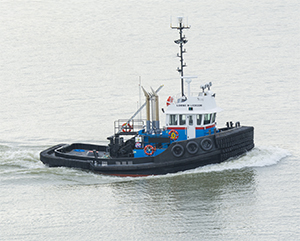It’s a positive sign whenever a company takes delivery of a new tugboat, and when a firm takes delivery of two new ones, it is all the more remarkable. When the company is only five years old, the marine community takes notice.
That happened in mid-February, when Ledcor Group’s marine division took delivery of Lorne M. Ledcor, the first of two 48-by-22.5-foot, 1,342-hp boats built by Bracewell Marine with an A.G. McIlwain Ltd. design.
Ledcor’s rapid rise has been a regular topic of conversation on the Vancouver waterfront ever since the construction consortium with operations in the U.S. and Canada formed a marine division. It started by buying six older tugs available in British Columbia, but lack of supply limited further purchases.
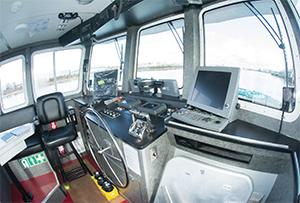 |
|
Designed as a day boat, the comfortable wheelhouse has a small galley and mess table. The watertight door on the starboard side leads to the forecastle. |
“We had 12 chip barges built in China in 2011,” explained Mark Houghton, chief operating officer of Ledcor’s Marine Division. “In 2015, we delivered more equipment built in China. Two 80-by-22-meter, 6,000-MT barges in February 2015 and a China-built Damen Stan tug with a pair of Cat C-18s with about 600 hp each. In July 2015, we delivered four 63-meter, 3,300-MT and two 73-meter, 3,800-MT flat deck aggregate barges that we put in service this past January.”
With more contracts in hand, the company began planning and building its two new McIlwain-designed tugs. These two boats have the same C-18 engines as the Damen boat but with a higher power rating of 671 hp to match the designed propeller size. On the new boats, they turn three-blade 64-inch Osborne propellers in Sylte-built nozzles through Twin Disc MG-5170 gears.
“With the transportation cost and a 25 percent import duty, the cost of building local is about the same as buying in China. Damen has stock hulls so they can be faster, but we decided to build locally,” explained Houghton.
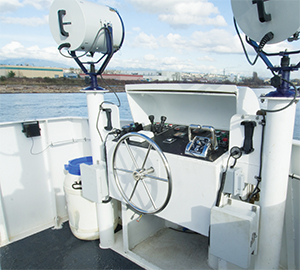 |
|
Top controls on a flying bridge give the best visibility when lining up a heavy tow for one of several swing bridges on the Fraser and Pitt Rivers. |
Ledcor chose a well-proven design for its new tugs from A.G. McIlwain Ltd. Stephen McIlwain made the final drawings following the death of his father and company founder Al McIlwain in May 2015 at age 82.
Houghton said, “We feel very fortunate to work with Stephen and the McIlwain family, and to continue the proud tradition of tug building in British Columbia by partnering with Bracewell Marine Group Ltd.”
Although the new boats have the same pair of C-18 Caterpillar engines as the Damen boat, they are, at 48 feet, slightly shorter than the 55-foot Damen tug but three feet wider. The Dutch design has a less pronounced sheer from the lower bow to the stern. The new tugs have a significantly higher bow as they will, in addition to their river work, haul some tows across the more open waters of the Gulf of Georgia where some significant weather occurs. Here, the 1,342 hp delivering 17.4 metric tons of bollard pull pays for itself.
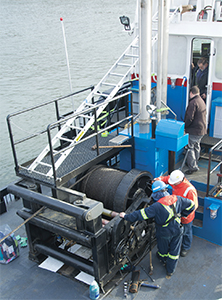 |
|
The new single-drum Burrard Iron Works towing winch with level wind. |
“When we make double or triple barge-tows, it may take additional time and burn 20 percent more fuel, but the returns to the company are a huge advantage. We can’t always do it, but when our dispatch can arrange it we want to have the power to take advantage of the opportunity,” Houghton explained.
In keeping with West Coast tradition, the wheelhouse is significantly taller than the European-designed tug. Fabricated from aluminum, it is mounted on legs that effectively insulate the cabin from engine noise transmitted through the steel hull. Nylon cushion mounts also help isolate the steel and aluminum components. Accommodations, accessed through a hatch located forward in the wheelhouse, lead down to bunks for the two crewmembers.
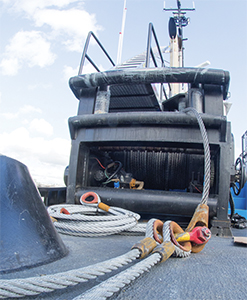 |
|
The tow line shackled to a pair of bridles, ready to go to work. |
The wheelhouse is set on a raised trunk that carries aft from the raised forecastle to provide additional engine room space. It also provides a platform for the aft set of controls just above the winch. Like most British Columbia tugs of this class, Lorne M. Ledcor has three control stations. In addition to the wheelhouse and aft deck, the tug has a flying bridge. Also common on British Columbia yarding tugs, this provides visibility for the operator when transiting bridges on the Fraser River where having the barge properly lined up with the tug is important to avoid allisions. All three control locations have winch controls and abort switches. The tugs also have retractable masts for fitting under low bridges.
The aft deck on the new tugs is set low to provide for a low mount of the towing winch. The new tugs are fitted with a beefy single-drum Burrard Iron Works towing winch with a dedicated Cat 3056 hydraulic pump engine. The winch drum is loaded with 1,500 feet of 1.25-inch wire supplied by Pacific Wire Rope.
“I have operated tugs at other companies,” Houghton said. “We had some of these heavy-built Burrard winches and they provided safe and reliable service for well over 30 years.”
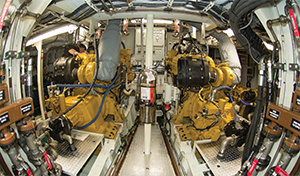 |
|
The pair of Caterpillar 671-hp C-18 mains fit easily in Lorne M. Ledcor’s engine room. |
Over the top of the towing winch, a railed grid provides a walkway for the deck hand to access a ladder that rests against the mast but can be tipped back to reach the bow of an empty barge. A well-fendered low transom allows the captain to back the tug in under the rake of the barge. The deck hand can then pivot the ladder on its base to gain quick, safe and easy access to the barge. Such barge work may be required several times on a watch to put up or take off the tug’s wire bridles.
A company well established in building yachts and workboats has, with these two newbuilds, proven itself in new tug construction as well. Bracewell Marine Group, located at the Shelter Island Marina on the Fraser River in Richmond, B.C., is a hands-on family operation with Lance Bracewell as president. The yard delivered the second of the two-tug order, Herb L. Ledcor, this spring. Working at its space in the Shelter Island Marina, the firm built the new boats amidst an ever-changing array of fish boats, tugs and pleasure crafts undergoing repairs.
The upstart Ledcor Group, with barely six years in business, has gained a pair of fine new tugs from the many years of tradition represented by the designer and builder.

